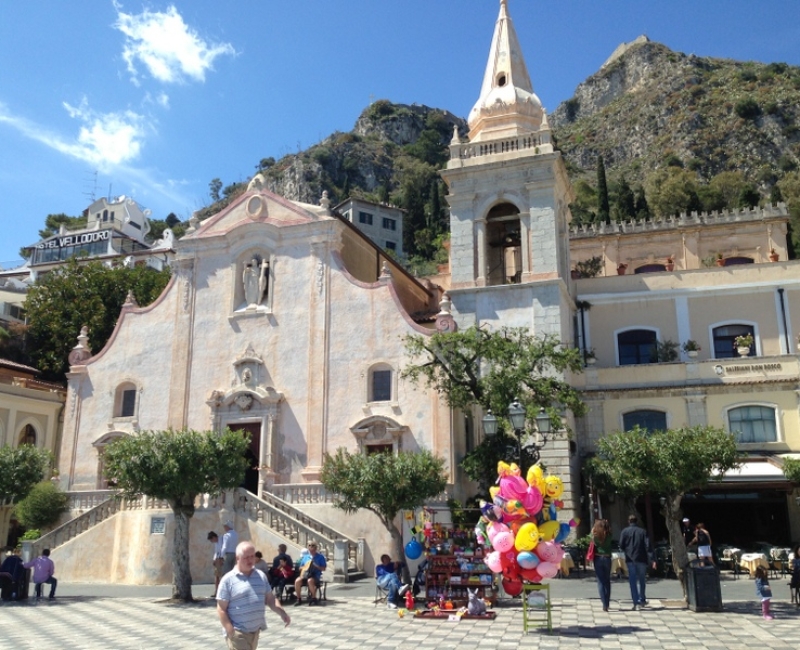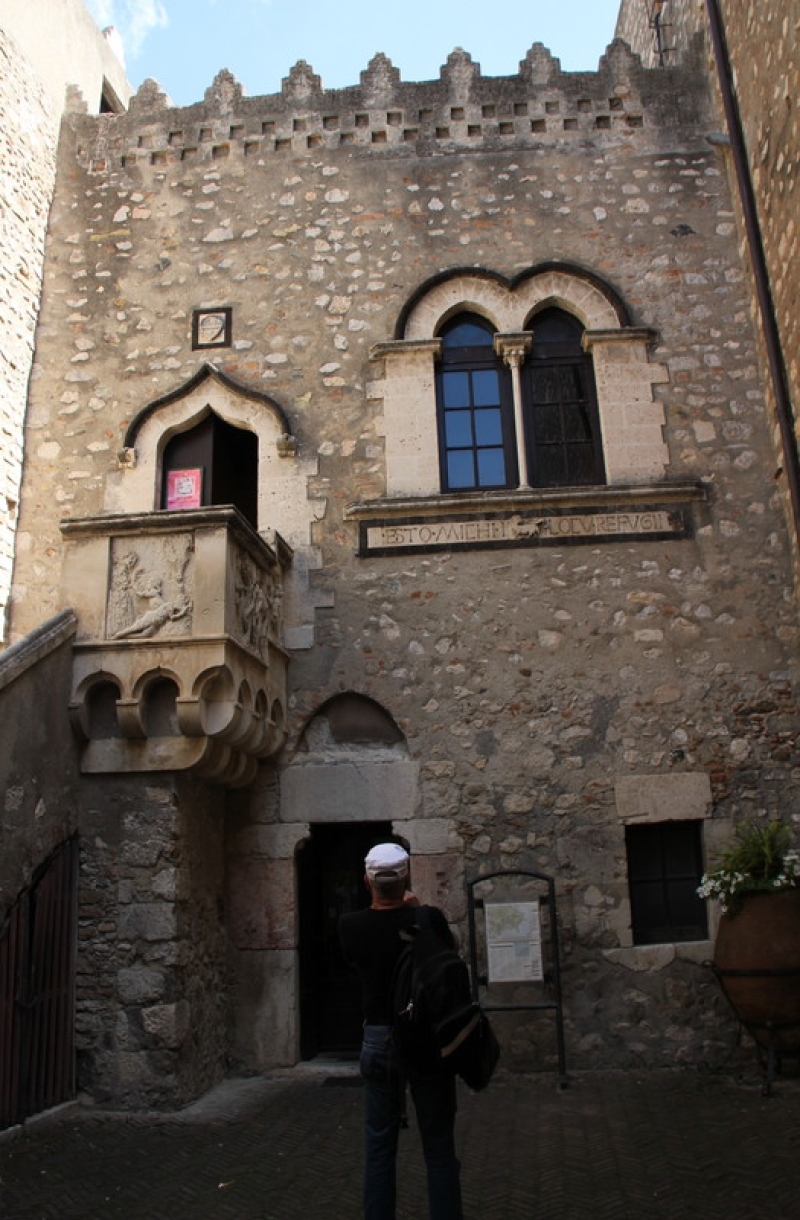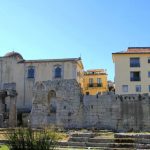Taormina, Sicily: Refuge of Ancients and Artists, Part 2 of 4
All photography by Stephen B. Chambers Architects, Stephanie Chambers
We’ve got to live, no matter how many skies have fallen.
D.H. Lawrence, Lady Chatterley’s Lover
Dallas architect, Steve Chambers, visits The Greek Roman Theatre with its breathtaking views of Mount Etna and miles of Mediterranean Sea, as seen from Taormina on Sicily’s northeastern coast.
Ancient Resort
Taormina is enchantment wrapped around a multitude of myths. The city, precariously set on Monte Tauro, rises 650 feet above the sea, dominating grand, sweeping bays along the eastern coast of Sicily. It offers visitors a dramatically memorable view of Mount Etna and over one hundred miles of Mediterranean Sea. Early Sicels, Greeks, Romans, Byzantines, Saracens, Arabs, Normans and Spaniards seemed to be in agreement. For centuries, it was the chosen locale for their ancient resorts. Taormina has also been attracting invaders, since it was founded as Tauromenium in the fourth century BC. Its past is a microcosm of Sicilian history. Those who arrived, conquered and eventually departed. On this day, only tourists with backpacks and suitcases disrupted our wandering.
Refuge to Artists and Writers
Taormina claims to be one of the originating sites of modern tourism. After Goethe’s book Italian Journey was published, the city became a featured stop on the Grand Tour of Europe in the 18th century. The photographer, Wilhelm von Gloeden, settled there in 1880 and made it famous to European cultural clubs with his provocative portraits of shepherd boys with Mount Etna in the background. Modern literary heroes followed. A quick roll call of celebrities included: Alexander Dumas, Johannes Brahms, Gustav Klimt, Richard Wagner, Oscar Wilde, Truman Capote, John Steinbeck, Nietzsche and DH Lawrence. Lawrence’s character, Constance Chatterley, was based on an Englishwoman living at Taormina during his stay there. He was among the many who went in the 1920s, seeking a place to live uninhibited and undisturbed by those who couldn’t understand him. It was eventually established as a locale with an inclination towards the bohemian and sexual. Today’s artists continue to seek it out as a port in the storm and an inspiring setting in which to create without judgment.
Is the Taormina Theater Greek or Roman?
Taormina’s most spectacular monument is the Teatro Greco, a magnificent amphitheater. If you doubt that ancient gods existed, sit a while among the ruins of this theater. You can almost hear cautionary tales spun by Aeschylus, Sophocles, Euripides and Aristophanes. While it’s called a Greek theater, there are examples of both Roman and Greek architectural traditions to be found here. Its origin is still open to debate among experts and critics. All their disputes would end if they remembered that Taormina was a Greek “polis.” Every ancient Greek town had its own theater, where the works of the famous authors were performed. The theater in Taormina is the second largest in Sicily, after the one in Siracusa. The later architectural contribution by the more ostentatious Romans was to enlarge the relatively small theater to stage gladiatorial combat. Further evidence that the Teatro is of Greek origin is in the well-cut bricks of Taormina stone (similar to marble) below the theater. Typical examples of the ancient Greek building techniques are the scene (background) and the orchestra (place for the musicians and close seating). The cavea, comprised of class-segregated terraced seating and subterranean caverns, appear to be Roman additions. The scene (skene) is formed by two series of Corinthian columns, recognizable by the shape of the capitals and their Acanthus leaf design. The Greeks worshipped nature and it’s evident in their theaters. Sea and sky were preferred background for actors to perform. The Romans tried to improve on nature and control the view by constructing a backdrop connecting the columns to a facade and proscenium. But, serious damage to the theater during many early attacks rendered a return to its appearance during the Grecian period, a magnificent panorama of the bay of Naxos and Mount Etna.
In Taormina’s Piazza Duomo is the Arab-Norman fortress cathedral and Baroque fountain crowned with a mythological half-woman-half bull, the symbol of the ancient city
The Duomo
The city’s “Duomo” is not a cathedral, but a fortress. The Norman-Arab church, built over an earlier Christian structure, dates from the twelfth century. Cattedrale di San Niccolo has a Latin-cross plan with three aisles and six minor altars in the two side aisles. The nave is held up by six monolithic columns, three on each side, in pink Taormina marble and with capitals featuring a foil and fish-scale decoration. The ceiling of the nave has wooden beams supported by carved corbels reproducing Arabian scenes with a Gothic style. The main portal was rebuilt in 1636 and has a large Renaissance-inspired rosette sculpted on it.
St. Pancras Church
Though captivated by the skulls and crossbones carved in the exterior stone of an edifice that reminds us more of a pirate ship than a church, we are uncertain of their meaning. The church’s origin, however, is clear. Santa Pancrazio was built on the ruins of a Greek temple dedicated to Isis in order to honor Taormina’s patron saint, Pancras, a martyr in the Eastern Orthodox Church. Parts of the temple’s cell can still be seen in the southern wall of the church. The early Rococo style church dates back to the second part of the 16th century, when this style was less ornate and used light colors, asymmetrical designs, curves and gold. Unlike the more political Baroque, Rococo was playful and witty. The main portal features jambs and architraves in Taormina stone. Two Ionian columns decorate each side of the portal with an organ above the portal. There are eight angels on the altar, four on each side, and a bust of God giving his blessing. A fresco picturing the torture of St. Pancras can be seen on the right of the main altar. In iconography, this saint is depicted as a world-weary old man with yellowing grey hair, vested as a bishop and holding a cross in his right hand, a book in his left.
Texas architect, Steve Chambers, enters the Palazzo Corvaja, which serves as a history museum and tourist bureau for Taormina
MORE PHOTOS AND VIDEOS BELOW RECIPE
Porta Messina and Porta Catania
In ancient times Taormina was protected by a circuit of walls with a triple fortification system, which looked towards Messina from the north and ended on the west on the side looking towards Catania. Traces of these walls can still be seen today not only in the center of the town where the clock-tower stands, but also at the two farthest ends of the town where there are two entrances, Porta Messina and Porta Catania.
Palazzo Corvaja
The Arabian dominion in Sicily lasted from the 9th to the 11th century and the Moslems remained in Taormina in particular from the year 902 to 1079. During the 11th century the Arabs reinforced the town’s defenses by building a tower, which is really the main part of today’s Palazzo Corvaja. The tower reminded the Arabs of their sacred “Al Ka ‘bah,” the first temple erected to God by Abraham at Mecca.
Ideal Vacation Locale
All photographs and videos by Stephanie and Steve Chambers.










